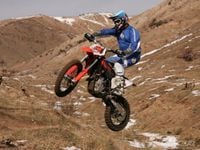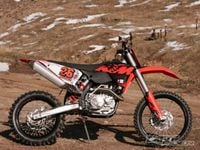2009 Ktm Xcw
2009 KTM 450 XC-W Web Test - Dirt Rider Magazine

Our KTM 450 XCW was a favorite with a lot of our riders, but more so with the tall riders like Scott Denison. Denison owns a KTM 300 XC two-stroke, but adapted well to the 450.
If you parked a 2008 and 2009 KTM 450XCW side-by-side, you probably wouldn't notice any difference but the graphics and some small color changes to some parts. We're okay with the look, since there are many changes hidden inside that have made a major difference.One year ago I would have said, "Forget the 450 XCW. The 530 weighs the same and has more and smoother power." Of course I would have also said that the XCW feels heavy, and that the 450 XC was a better bet. But that was then. In the meantime, KTM redesigned the shock internals and the fork's upper and lower tubes.KTM has managed to get the rear shock working very well, and especially for off-road. To accomplish that feat, the shock has two separate pistons on the same shaft. A large needle - something like a much larger version of a carburetor needle - is located in the shock body. As the shock gets deep into the travel, the needle enters the shock shaft, and it closes off the free bleed for the second piston. Rather than relying on a linkage to decrease leverage on the shock late in the travel, the WP PDS system utilizes far more valving control over the oil flow.For 2009 the second PDS piston has a larger center opening, and the shock needle is larger as well, and the end result is that the second piston has less crossover to the damping early in the stroke. It turns out that this is a good thing.Up front there are small internal changes, but the shape of the outer tubes and the manufacturer and material of the inner tubes is much closer to that used by Kayaba and Showa. The difference in suspension compliance and control is amazing. If you are used to a linkage bike you may find the shock a little more active and a bit hoppy feeling under braking, but for most riders the feeling is reduced from past models, and the acclimatization period is profoundly shorter.A new front caliper has maintained the stunning brake power at previous levels, but the control and feel of the brake is vastly improved, and that is a good thing. These bikes stop like no Japanese bike. As always, the hydraulic clutch works extremely well. It isn't that the hydraulic design offers any advantages of leverage over a cable system, but the friction of the inner cable wire against the cable hosing is gone. In addition, hydraulic is more instant since there is no cable flex. Add in the fact that a hydraulic system self-adjusts, and you have a classy clutch. Another welcome feature is the material of the lever. We bent the lever, and then carefully bent it back, and it showed no inclination to crack or break. Naturally, the down side is the master cylinder is much more expensive than an ordinary clutch perch if it is broken or damaged.For 2009, though, the clutch is less vital, because it is required less often. A cam change has boosted the bottom and middle rpm power, so this engine is far more responsive, happier to gain rpm and blessed with more meat to the power at all rpm. The need we felt for lower gearing for tight trails in past years is much less urgent, or even superfluous. After all, there are six nicely spaced gears in that box, and they cover trail conditions from survival slow to get-a-ticket-on-the-freeway fast. On dry and somewhat slippery terrain, our bike indicated approximately 85 miles an hour. A traction situation with less wheelspin would probably push the bike through the wind a bit faster, but that felt plenty fast for us.Somehow this combination of added performance and a "happier" engine character conspires with the suspension to steal away the weight feel of the bike. Sure, it is the lightest bike in the test by anywhere from four to 21 pounds, but it feels lighter than it is. The XC (with no kickstart system at all and a five speed) is still over 10 pounds lighter, but now the difference in weight feel is not so great. With this light feel the XCW goes straighter in whoops and remains composed at speed. It is happiest in twisty, turny conditions where you keep a little momentum and flow. The chassis has good front wheel traction, and the bike carves pretty well on flat ground, and it cuts in nicely for sand and mud. It never really wags the head enough to be a serious issue, but is busy enough that a steering damper is a welcome, but no required addition.Off-road accoutrements are somewhat minimal, but the KTM does come with a tucked-away kickstand, flag-type handguards, frame and muffler guards and a digital speedo/odo. It has lighting capability, but no lights. The only thing truly missing is a skid plate or other type of engine case protection. The frame rails actually do a decent job protecting the center cases, but the ignition cover is vulnerable. The only other chink in the off-road armor is that the KTM - with no coolant catch tank - will get hot, boil over and lose coolant while the Japanese machinery simply cycles the overflow back in when the engine cools.As far as rider position goes, the KTM is roomy and easy to move around on, and if you want to make changes, the handlebar position is adjustable, and both KTM and the aftermarket offer taller and lower seats. The Japanese do still have a seat advantage according to most of our test guys. Some riders felt the bike was a little wide when they rode standing, but most adapted quickly. Mileage and range are good despite holding only a half-gallon more than the BMW or Honda thimbles, and part of the thanks goes to the engine not needing rpm to make good ground speed and a gear for every situation that helps the bike digest dinosaurs judiciously.

KTM didn't bother much with the outer appearance, but lavished R&D; dollars on the engine and suspension. It was money well-spent, and the bike is a much more effective trail weapon in 2009.
KTM could have had this class by the throat except for one thing: the Husaberg. While the KTM has an advantage for faster and more open riding, in tight conditions the 'Berg has an edge for most riders. Nevertheless, as an all-around package the KTM has more to offer, since it is not so narrowly focused, and routine maintenance - like shock spring preload adjustments are much easier. The KTM also suits tall riders more easily. Add a proven reliability record and strong resale, and it is easy to see why orange has become the color of off-road.MSRP: $8798.00
Claimed Weight (tank empty): 248 lb.
Actual Weight (tank full): 276 lb.
Seat Height: 37.8 inches
Footpeg Height: 16.9
Ground Clearance: 13.5
Street Legal (y/n): N
Fuel capacity: 2.4 gal.
Transmission: 6-speed
Manufacturer Website: www.KTMusa.comOpinions
From the second I got on the bike I noticed that it was very light. The bike handles great in the tight and twisty trails and it is so light, it felt like I was riding my 200. The suspension was pretty stiff on the trail and on the mx track but it stayed straight (just beat you up a little). The bike turns very good and stays predictable in the corners; it goes were you want it too. This bike had plenty of power with the XC-W gearbox, great for tight trails and a very fast 6th gear for when you need it. The clutch pull is very smooth but one thing I noticed is the lever was in an awkward position and it caused my hand to get tired faster. The steering felt a little tight and a steering stabilizer would have been nice for the high speed sections. The best quality of this bike by far is its light and nimble feeling.
Kevin DeJongh: 6'0"/150 lb. /ExpertDuring all of our 450 testing the KTM was my favorite bike. Enough so that I purposely left it till the last bike of the day to avoid making the other bikes feel worse than they are. I just fit this bike and it fits me. So when the annual Soboba Trail Ride, the tightest and most technical organized ride I do each year, the XCW was the obvious choice. Because I can't think of a stronger word, I'd say it was perfect for the day. While other struggled with fuel capacity, I never hit reserve. The suspension and engine kept my body from hitting reserve as well. Even I wouldn't mind a lower seat height, but I just had to mount my tall seat from Enduro Engineering. That seat is all I needed to make my day. In '08 I touted the 530, but in '09 I say, who needs it?"
Karel Kramer: 6'1"/225 lb. /B riderI rode all of the 450s, and the KTM is my favorite. It just does everything that I want it to. It felt very agile. I even rode the KTM on the track with no problem. It has that low-end grunt that allows you to go into low-speed sections and roll it on without clutching it a lot. With this engine I didn't really notice the wide-ratio transmission. First is not too low, and it pulls all the gaps easy. It doesn't have a big hit, but there is always plenty of torque. On tricky sections I would have to charge harder on the other bikes.
Billy Oulette: 5'10"/155 lb. /Former national pro motocrosserI didn't ride the Husaberg, but I thought the KTM smoked all the other bikes. I have the '06 450 XC, and it feels heavier in general, and more front end heavy. The new bike stays straight on hits better, and it never really does anything weird. The power feels tame with no hit, but it runs as hard as or harder than my XC does, and it does that while being quieter. It feels more nimble than my bike as well. None of these 450s are light, but this one feels light. It would be my pick for a 450 off-road.
Rob Waite: 5'10"/160 lb. /Expert trail rider
Source: https://www.dirtrider.com/tests/off-road-bikes/141_0904_2009_ktm_450_xcw_web_test/

Tidak ada komentar: